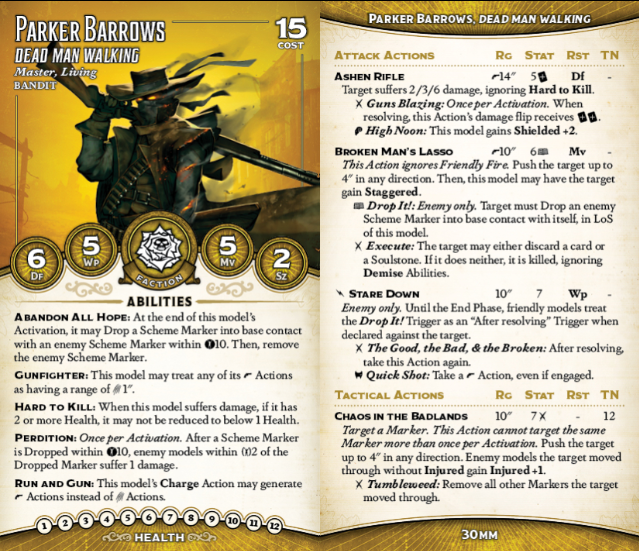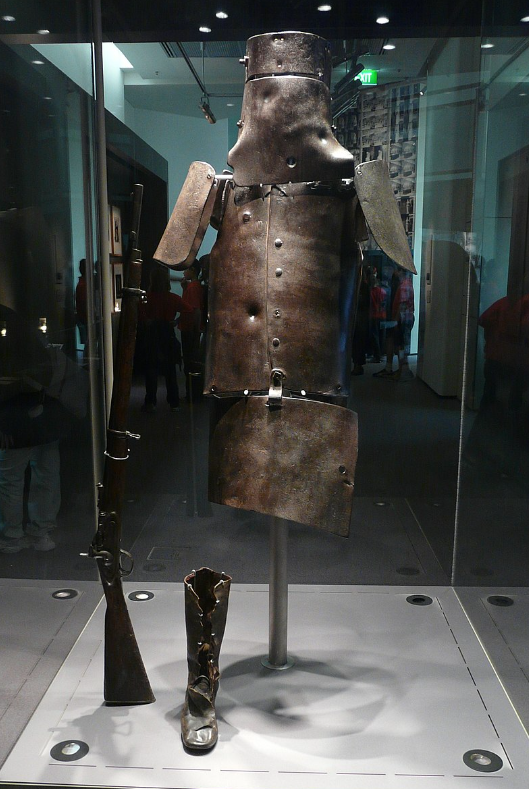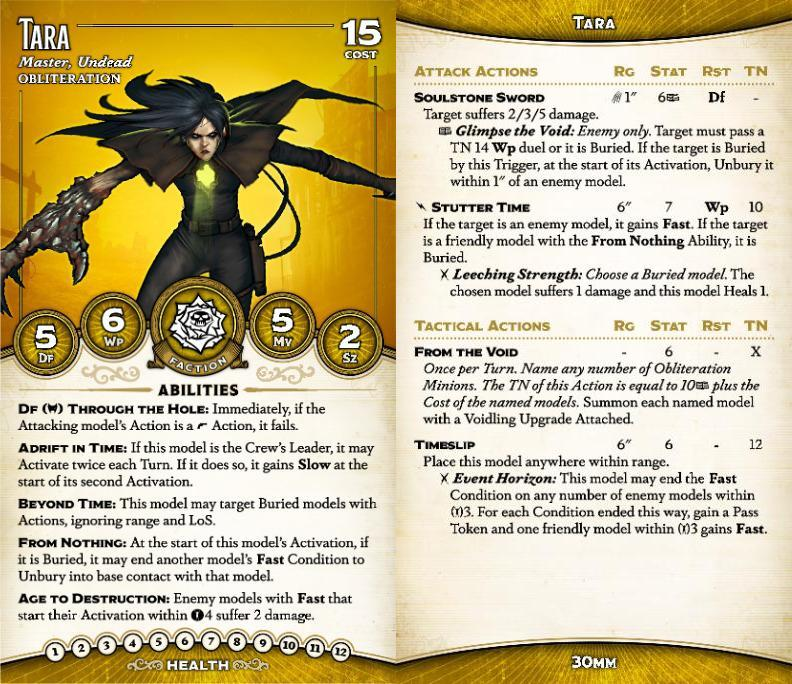The Good, the Bad, and the Ugly - Bandits are a loveable mess
Hi again everybody! It is I, Azahul, putting together something a little bit more specific than the wide-ranging high concept article that was my first post on the blog. With the groundwork in how I look at the game established by that first article (found here), I wanted to take a bit of a closer look at Parker Barrows and the Bandit Keyword. Before we begin, let me make it clear that this isn't really intended as a competitive analysis of the Keyword, or even a how-to-play guide in any sense. I'm more focussed on the theme of the Keyword and perhaps a bit of its broader design goals as I understand them.
I have a long history with the Bandit Keyword. I tend to think of my journey in this game as beginning with the Viktorias, playing exactly one game with them, and deciding I wanted to focus on something a bit more convoluted. I settled on Hamelin and the Plague Keyword, and they quickly became my main love in the game. But, in truth, it is worth noting that there was an intermediate step. I started playing the game in early 2020 during the first release cycle of M3E, and at that time the Plague Keyword's new boxes hadn't yet actually been released. So, looking through the Plague models, I noticed that one of them was a dual Bandit/Plague model. I figured it made sense then to try out the Bandit Keyword while I waited for Plague to release, since I would one day have a model that could bridge the two crews. Little did I know that this model, Benny Wolcomb, would become my one true Malifaux love.
 |
| Take this man home to meet the family. |
And I'm also going to talk about how it all doesn't really work.
Daylight robbery
Bandit is one of those Keywords where there isn't really just one Keyword-specific rule shared by every model in the Keyword. Instead there are about three, maybe four if you make an argument for Gunfighter, but many models in the Keyword are missing one or two of these rules so you could just about build crews that lack any shared traits. It is a little bit annoying, because you do sometimes get surprised by the lack of a particular rule on a model that you expect to be there because it is otherwise common in the Keyword. Our three rules are:
Run and Gun - A front of card ability that allows the Bandit to generate a ranged attack when they charge.
Life of Crime - A front of card ability that allows the Bandit remove a nearby scheme marker when they activate to gain Fast.
Drop It - A trigger usually found on the ranged attacks of the crew, though a handful of models have it on their melee attacks instead. Forces the opponent to drop one of their own scheme markers base to base with their model.
There is also a bit of a sub-theme of models, usually models dual-wielding weapons, having Stat 5 attacks with a built-in positive to the flip.
All of these rules push in broadly the same direction, making Bandit a Keyword that always has plentiful actions to try and accomplish their objectives, but they're usually not very good actions.
 |
| The prime example of "not very good actions". You are about as likely to see these models on the table as you are to find someone spelling their name without a 't'. |
More importantly, there is a pretty easy to understand narrative being built by the combination of these actions. The narrative, broadly speaking, is that the Bandits rush forwards firing wildly at their opponent, forcing the opposing models to drop their valuables at their feet by declaring "Drop It" triggers. Then, in later activations, the Bandits scoop those valuables up off the dirt, motivating the Bandits to take additional actions with their Life of Crime ability, or in return for other rewards as seen on other models in the Keyword that can use scheme markers as fuel for their actions.
Weight of Numbers
Design-wise, there is a funny thing going on in Bandit. Outside of Mad Dog Brackett, who probably needs no introduction, almost every Bandit model is Stat 5 on their attacks. Stat 5 is widely regarded as not very good. It usually means that you are tied with or less than the Df of the target (almost guaranteed to be less than if the opponent has any sort of Cover, but Run and Gun is thankfully good at mitigating that by letting you find angles for shots that avoid the worst of terrain), and that in turn makes it hard to cheat to hit your attacks and get consistent value out of them.
However, there are two aspects to this that offset that disadvantage. One is that a decent number of models make those Stat 5 attacks with a built in positive to their stat. These models are Parker Barrows himself (both version), Convict Gunslingers, Sue, Pearl Musgrove, and Wokou Raiders. The latter is a little unusual because the positive is on their melee attack instead of their gun. The other aspect is Life of Crime, meaning many of these models have a way to get three actions.
What this means in practice is that a Bandit model is more likely to win an initial duel, due to the benefit of flipping two cards, but will have a harder time guaranteeing a hit once cheating becomes involved. However, since they have many attacks and their attacks are usually fairly low value, Min 2 attacks, cheating defensively to avoid their attacks is broadly inefficient. There will be a lot of them, you will usually be cheating first, and you won't avoid a lot of damage against the ones you can afford to dodge.
 |
| This man, like many in his Keyword, is an advocate of "spray and pray" as an ideology. |
This sort of approach isn't really very popular in Malifaux. The Control Hand gives you a lot of certainty in how you plan your approach to the game, and the idea of just flipping a lot of cards and seeing what happens doesn't really appeal to many folks. It also, simply put, isn't very consistent the way many game plans in Malifaux can be. But there is some value here. I look at models like the Convict Gunslinger and I consider them excellent in a role I would term "tertiary beater". In that if you have two other models in your crew who are your main damage dealers, who have Stat 6 attacks that generate consistent value when you funnel your hand of cards through them, then by the time you activate the Gunslinger the low Stat of their attack is rarely going to matter anyway. Your hand has already been spent, so the idea of a model that will just flip a bunch of cards and probably get some work done is pretty appealing.
On the Run
Unfortunately, the Bandit Keyword is a bit of a mess. If you looked closely at the Convict Gunslinger above, you might have noticed his Cost of 8 but his inexplicably low hit points of 7. That is almost unheard of outside of Armour 2 models or models who otherwise have extremely potent defensive rules, and his are... not that. That is only scratching the surface. A recurring feature of discussion in the Outcasts Discord on the Wyrd server is explaining to new players how "Drop It" means, in practice, a couple of key rules across the Keyword don't work.
In short, and very briefly, the Line of Sight rules in the rulebook say that a model with a 30mm base standing exactly between two other models with 30mm bases block line of sight between those two models. Tangent lines don't exist in Malifaux, apparently.
Drop It allows the opponent to place the scheme marker. It has to be in the Line of Sight of the model who declared the trigger, but it doesn't have any other limitation. So if you have an aura, like Perdition on Parker Barrows, Dead Man Walking or Trigger Finger on the Bandidos above, you can place the marker on the opposite side of your model's base to the model with the aura and block Line of Sight. This, effectively, removes all possible interaction between the Drop It trigger and all sorts of core synergies in the Keyword presumably built around it.
 |
I'm not even convinced Wyrd is aware of these issues, since reading Parker2's card really gives me the impression that he is meant to use Stare Down on a model and then have his crew focus fire it, dropping schemes with Drop It regardless of if they win or lose the duel for guaranteed pulse damage.
In reality, the best Parker2 crews I have written are the ones who drop scheme markers in any way other than Drop It, because at least then you will actually get to use Perdition. This seems like the kind of thing that would come up during the design process, but it pushes you into a way of playing Parker that strongly de-emphasises the mobility of Run and Gun, the racing in and out of danger as you force the enemy to drop their valuables, and instead look for ways of getting scheme markers onto the table that avoid interacting with your opponent.
I like Parker2, he is fun for me to play, but every now and again I do pause and take stock of how little of the Bandit narrative actually comes through in his playstyle.
Parker1 is a little bit better, but he has his own issues.
Cashing Out is immensely flavourful and a really cool way of interacting with all those enemy scheme markers you produce, but there is a significant flaw here. You know how we just established that Bandit models don't use cards well? Well, most of them can't use Soulstones either. And here we have a Master who is... all about generating stones and cards. The result is a Master who really doesn't want to hire his Keyword, he is fundamentally at odds with the Keyword's design. Honestly, based on this card, what Parker Barrows most seems to want is a bunch of OOK Henchmen with good attacks.
They also seriously hurt his ability to generate cards when they errata'd the Wanted Criminal upgrade a while back. This isn't really important, but it makes me very sad that I no longer want to slap Wanted Criminal on one of Malifaux's Most Wanted criminals.
The Future of Bandit
As my ramble here draws to a close, it is hard to tell where Bandit is going in the future. The most recent releases, Ella Mae Chesterfield and Six-Armed Six Shooters, both diverge from Bandit design on a couple of fronts. Both models are armoured in a Keyword that traditionally hasn't had access to that sort of staying power. Both models forswear the "Stat 5 with a positive" approach, and instead just have solid, reliable Stat 6 guns. Neither model has Life of Crime, only Six Shooters has Run and Gun, and only Ella Mae has Drop It. Presumably this significant separation in design from the rest of the Keyword is related a little to their existence as dual-Keyword models, but I am a bit worried about it as a design direction. They kind of read like a solution to the Bandit design issues, removing the reliance on Drop It triggers and scheme markers, raising the Stat on the attacks to make them reliable and losing Life of Crime to compensate, and so on. I like both these models, I have already played a number of games with them before their physical release and they feel great to pilot. All of that said, I really hope that the future of Bandit isn't fixing their problems by removing their flavour. I really, truly like what Bandit is trying to do, but I think it is clear that a few tweaks are needed to actually get it work. Having Masters who actually work with their Keyword's mechanics would be a start.
But, since we're on the subject of adding armoured Bandits, I am going to address Wyrd directly just before I finish. They are obviously reading this, my opinions are informed and well-reasoned and they know I am worth listening to. This next bit is far more important than any possible Errata suggestions or other nonsense. This is big.
Ahem.
Add Ned Kelly to Bandit! (Please)
For those who aren't deeply familiar with a random, if somewhat famous, little incident in Australian criminal history, Ned Kelly was a man in the 1870s who robbed banks and rode away on horseback and generally behaved a lot like an outlaw from the Wild West. For some reason we called them Bushrangers in Australia, which creates some weird associations if you try to think about what says about Park Rangers for more than a few seconds. His exploits were also the subject of the first ever feature length narrative film, so I guess you can blame him for Hollywood? Maybe?
Anyway, long story short, for most of his life Ned Kelly really didn't do much different from the standard outlaw template already represented well in the Bandit Keyword. However, towards the end of their career, he and his gang found the time (and possibly some friendly blacksmiths) to make suits of crude armour like the one seen above. They were big and heavy and cumbersome but... you know, they stopped bullets. It didn't help the Kelly gang in the end, they were killed or captured in a big old shootout with the police not long after (where the armour was definitely used), but boy it left an enduring legacy in the Australian psyche.
The armour was used round about 1880, which is a little bit early for when Malifaux is set, but it isn't like it would be the only anachronism of that sort in the game. And a little bit of Australian representation in Malifaux would be cool.
So, uh, Wyrd... please?




Comments
Post a Comment